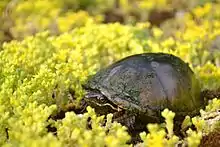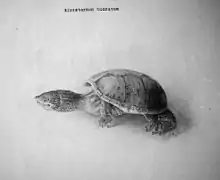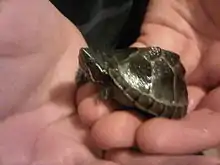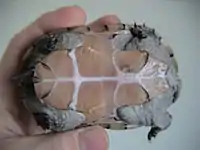Sternotherus odoratus
Sternotherus odoratus is a species of small turtle in the family Kinosternidae. The species is native to southeastern Canada and much of the Eastern United States. It is also known commonly as the common musk turtle, eastern musk turtle,[4] or stinkpot due to its ability to release a foul musky odor from scent glands on the edge of its shell, possibly to deter predation.[5] This turtle is grouped in the same family as mud turtles.[6]
| Sternotherus odoratus | |
|---|---|
 | |
| Scientific classification | |
| Kingdom: | Animalia |
| Phylum: | Chordata |
| Class: | Reptilia |
| Order: | Testudines |
| Suborder: | Cryptodira |
| Family: | Kinosternidae |
| Genus: | Sternotherus |
| Species: | S. odoratus |
| Binomial name | |
| Sternotherus odoratus | |
| Synonyms[3] | |
| |
Description


The stinkpot is a small black, grey or brown turtle with a highly domed shell. It grows to a straight carapace length of approximately 5.1–14 cm (2.0–5.5 in) and averages in weight at 603 g (1.329 lb).[7] It has a long neck and rather short legs. The yellow lines on the neck are a good field marker, and often can be seen from above in swimming turtles. Males can usually be distinguished from females by their significantly longer tails and by the spike that protrudes at the end of the tail. The anal vent on the underside of the tail extends out beyond the plastron on males. Females are also typically larger than males. The head is vaguely triangular in shape, with a pointed snout and sharp beak, and yellow-green striping from the tip of the nose to the neck. Barbels are present on the chin and the throat. The plastron is relatively small, offering little protection for the legs, and has only one transverse, anterior hinge.[8] Algae often grow on their carapaces. Their tiny tongues are covered in bud-like papillae that allow them to respire underwater.[9]
Behavior
The eastern musk turtle is almost entirely aquatic, spending the vast majority of its time in shallow, heavily vegetated waters of slow moving creeks, or in ponds. It typically only ventures onto land when the female lays eggs, or in some cases, to bask. It can climb sloping, partially submerged tree trunks or branches to as high as 2 m (6.6 ft) above the water surface, and has been known to drop into boats or canoes passing underneath.[8] It is a poor swimmer and can most often be found walking along the bottom of its native habitats, which include swamps, marshes, ephemeral pools, and large rivers and lakes.[6] Its defense mechanism is to excrete a musk scent from a small gland in its underside, hence the name musk turtle. This is used to scare away predators and natural enemies. If harassed, a wild stinkpot often will not hesitate to bite. Because its neck can extend as far as its hind feet, caution is required when handling one.
Diet
The stinkpot is carnivorous, consuming a wide variety of aquatic invertebrates including crayfish, freshwater clams, snails, aquatic larvae, and various insects. It will also eat fish, tadpoles, and carrion. A hatchling's diet is much more carnivorous than an adult's, and may slowly acquire a taste for aquatic plants as the turtle matures.
Habitat
S. odoratus turtle is found in a variety of wetland habitats and littoral zones, particularly shallow watercourses with a slow current and muddy bottom.[10] Although it is more aquatic than some turtles, it is also capable of climbing, and may be seen basking on fallen trees and woody debris.[11] Fallen trees and coarse woody debris are known to be important components of wetland habitat, and may be particularly beneficial to basking turtles.[12] Like all turtles, the stinkpot must nest on land, and shoreline real estate development is detrimental. S. odoratus is also commonly found on roads during the nesting season, having fallen victim to road mortality, particularly after heavy rainfall.[6] It hibernates buried in the mud under logs, or in muskrat lodges.[13]
Reproduction
Breeding of the eastern musk turtle occurs in the spring, and females often lay between 2 and 9 elliptical, hard-shelled eggs in a shallow burrow or under shoreline debris. An unusual behavior is the tendency to share nesting sites; in one case there were 16 nests under a single log.[14] The eggs hatch in late summer or early fall after an incubation period of 100 to 150 days, making this turtle a species that displays delayed emergence.[15] Egg predation is a major cause of mortality, as with many turtle species. In one Pennsylvania population, hatching success was only 15 percent, and predators alone destroyed 25 of 32 nests.[14] Hatchlings are usually less than one inch long and have a very ridged shell which will become less pronounced as they age and will eventually be completely smooth and domed. Its lifespan, as with most turtles, is quite long, with specimens in captivity being recorded at 50+ years of age.

Geographic distribution
The common musk turtle ranges in southern Ontario, southern Quebec, and in the Eastern United States from southern Maine in the north, south through to Florida, and west to central Texas, with a disjunct population located in central Wisconsin.
Taxonomy
The species now known as Sternotherus odoratus was first described by the French taxonomist Pierre André Latreille in 1801, from a specimen collected near Charleston, South Carolina. At the time, almost all turtles were classified in the genus Testudo, and he gave it the name Testudo odorata. In 1825, John Edward Gray created the genus Sternotherus to include species of musk turtles, and it became Sternotherus odoratus. The species has been redescribed numerous times by many authors, leading to a large amount of confusion in its classification. To confuse it further, the differences between mud turtles and musk turtles are a point of debate, with some researchers considering them the same genus, Kinosternon.
Conservation status
Though the common musk turtle holds no federal conservation status in the US and is quite common throughout most of its range, it has declined notably in some areas, and appears to be more sensitive than some native species to human degradation of wetlands.[16] It is listed as a threatened species in the state of Iowa. It is listed as a species at risk in Canada, and is protected by the federal Species at Risk Act (SARA).[17] It is also protected under Ontario's endangered species act.[18] In this part of its range, only wetlands with minimal human impact have robust populations.[16] Road mortality of breeding females may be one of the problems associated with human development.
In captivity
Due to its small size, the common musk turtle generally makes a better choice for a pet turtle than other commonly available species, such as the red-eared slider (Trachemys scripta elegans). Throughout its range, wild-caught specimens are commonly available, but the species is also frequently captive-bred specifically for the pet trade. (In the United States, USDA regulations ban the sale of turtles under four inches long as pets. This technically excludes most musk turtles, as most specimens found are smaller than 4 inches.) It readily accepts a diet of commercially available turtle pellets, algae wafers, and various insects, such as crickets, snails, mealworms, bloodworms, earthworms. A varied diet is essential to a captive turtle's health and it is important to note that it should not be fed with turtle pellets only. A captive turtle being fed a high protein diet may develop vitamin A and E deficiencies. Supplemental calcium in the form of commercial powders or a cuttle bone is also a must. Aquatic plants (water lettuce, duckweed, etc.) can also be provided, as some musk turtles prefer more vegetables in their diet than others. Though less sensitive to limited access to UV lighting, common musk turtles require ultraviolet (UVA and UVB) lighting as most other turtle species do for proper captive care. As a bottom dweller, the common musk turtle is rarely seen basking, but a basking area should still be provided.
References
- van Dijk PP (2011). "Sternotherus odoratus". IUCN Red List of Threatened Species. 2011. Retrieved June 7, 2012.CS1 maint: ref=harv (link)
- "Sternotherus odoratus ". ITIS (Integrated Taxonomic Information System). www.itis.gov.
- Fritz & Havaš (2007).
- "Eastern Musk Turtle (Sternotherus odoratus)". Ontario Nature. Archived from the original on 2016-07-11.
- Ernst et al. (1994), p. 148.
- Vitt, Laurie J.; Caldwell, Janalee P. (2014). Herpetology: An Introductory Biology of Amphibians and Reptiles, Fourth Edition. Amsterdam: Academic Press. 757 pp. ISBN 9780123869197. OCLC 839312807.
- "Virginia Turtles – Average Adult Sizes, Virginia Size Records & Overall Size Records" (PDF). Virginia Herpetological Society. Retrieved June 7, 2012.
- Conant (1975).
- Walker, Matt (May 20, 2010). "Turtle 'super tongue' lets reptile survive underwater". BBC News. Retrieved May 20, 2010.
- Ernst et al. (1994), pp. 139–140.
- Ernst et al. (1994), p. 142.
- Keddy (2010), p. 229.
- Ernst et al. (1994), p. 143.
- Ernst et al. (1994), p. 146.
- Gibbons, J. Whitfield; Nelson, David H. (1978). "The Evolutionary Significance of Delayed Emergence from the Nest by Hatchling Turtles". Evolution. 32 (2): 297–303. doi:10.2307/2407597. JSTOR 2407597. PMID 28563736.
- DeCatanzaro & Chow-Fraser (2010).
- "Eastern Musk Turtle". Species at Risk Register. Government of Canada. Retrieved June 7, 2012.
- "Eastern Musk Turtle". Ontario's Biodiversity: Species at Risk. Royal Ontario Museum. September 2009.
Bibliography
- Conant, Roger (1975). A Field Guide to Reptiles and Amphibians of Eastern and Central North America, Second Edition. Boston, MA: Houghton Mifflin. ISBN 0-395-19977-8.
- DeCatanzaro, Rachel; Chow-Fraser, Patricia (2010). "Relationship of road density and marsh condition to turtle assemblage characteristics in the Laurentian Great Lakes". Journal of Great Lakes Research. 36 (2): 357–365. doi:10.1016/j.jglr.2010.02.003. S2CID 85570388.
- Ernst, Carl H.; Lovich, Jeffrey E.; Barbour, Roger William (1994). Turtles of the United States and Canada (2nd ed.). Washington, DC: Smithsonian Institution Press. ISBN 978-1-56098-346-0.
- Fritz, Uwe; Havaš, Peter (2007). "Checklist of Chelonians of the World" (PDF). Vertebrate Zoology. 57 (2): 263–264. Archived from the original (PDF) on December 17, 2010.
- Keddy, Paul A. (2010). Wetland Ecology: Principles and Conservation (2nd ed.). Cambridge, UK: Cambridge University Press. ISBN 978-0-521-78367-5.
External links
| Wikimedia Commons has media related to Sternotherus odoratus. |
| Wikispecies has information related to Sternotherus odoratus. |
- Tortoise Trust: Common Musk Turtle
- Eastern Musk Turtle, Ontario Nature
- The Center for Reptile & Amphibian Conservation: Common Musk Turtle
- Sternotherus odoratus in Connecticut
- Common Musk Turtle, Reptiles and Amphibians of Iowa
Further reading
- Behler JL, King FW (1979). The Audubon Society Field Guide to North American Reptiles and Amphibians. New York: Alfred A. Knopf. 743 pp., 657 color plates. ISBN 0-394-50824-6. (Sternotherus odoratus, p. 445 + Plate 319).
- Boulenger GA (1889). Catalogue of the Chelonians, Rhynchocephalians, and Crocodiles in the British Museum (Natural History). New Edition. London: Trustees of the British Museum (Natural History). (Taylor and Francis, printers). x + 311 PP. + Plates I-III. (Cinosternum odoratum, pp. 37–38).
- Goin CJ, Goin OB, Zug GR (1978). Introduction to Herpetology, Third Edition. San Francisco: W.H. Freeman. xi + 378 pp. ISBN 0-7167-0020-4. (Sternotherus odoratus, pp. 142, 263).
- Gray JE (1825). "A Synopsis of the Genera of Reptiles and Amphibia, with a Description of some new Species". Annals of Philosophy 10: 193-217.(Sternotherus odorata, new combination, p. 211).
- Latreille PA (1802). In: Sonnini CS, Latreille PA (1802). Histoire Naturelle des Reptiles, avec figures dessinées d'après nature. Tome Premier [Volume I]. Première partie. Quadrupèdes et bipèdes ovipares. Paris: Deterville. xxii + 280 pp. (Testudo ornata, new species, pp. 122-124).
- Netting MG, Richmond ND (editors) (1970). Pennsylvania Reptiles and Amphibians. Third Edition, Fifth Printing. Harrisburg Pennsylvania: Pennsylvania Fish Commission. 24 pp. (Sternotherus odoratus, p. 11).
- Powell R, Conant R, Collins JT (2016). Peterson Field Guide to Reptiles and Amphibians of Eastern and Central North America, Fourth Edition. Boston and New York: Houghton Mifflin Harcourt. xiv + 494 pp., 47 plates, 207 figures. ISBN 978-0-544-12997-9. (Sternotherus odoratus, p. 229 + Plates 19, 21).
- Smith HM, Brodie ED Jr (1982). Reptiles of North America: A Guide to Field Identification. New York: Golden Press. 240 pp. ISBN 0-307-13666-3 (paperback), ISBN 0-307-47009-1 (hardcover). (Sternotherus odoratus, pp. 28–29).
